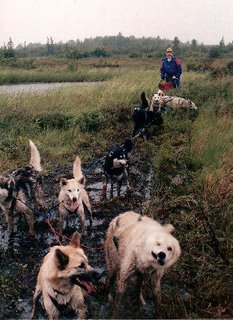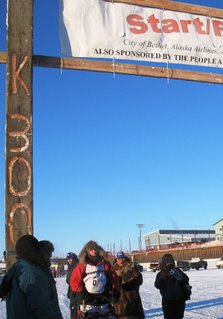Training Sled Dogs and the K300

Maintaining a well-trained team of sled dogs is a year-round endeavor, but the fun part is in the winter. Fortunately for those of us in southwest Alaska, winter lasts for seven to eight months. Late summer/early fall training consists of trucking the dogs out to open tundra and hooking them up to a four-wheeler or an old beater sled and letting them drag it around for a half-hour or so at a time. Though they shed much of their thick undercoats during the summer, they can still get overheated easily in warm weather, which is very bad for their attitude and their work ethic.
 Summer training runs are usually short, and the goal is strength training. It is slow, hard pulling on bare tundra. The dogs love riding in the truck and the chance for an outing. Henry’s dogs can be released from their chains and will run directly to the truck and jump in the back for the ride. The summer routes usually involve splashing through streams, ponds, mudholes and deep brush; the dogs come home muddy and happy, and the musher, muddy and tired. Summer training runs are a lot more work than winter runs.
Summer training runs are usually short, and the goal is strength training. It is slow, hard pulling on bare tundra. The dogs love riding in the truck and the chance for an outing. Henry’s dogs can be released from their chains and will run directly to the truck and jump in the back for the ride. The summer routes usually involve splashing through streams, ponds, mudholes and deep brush; the dogs come home muddy and happy, and the musher, muddy and tired. Summer training runs are a lot more work than winter runs.By October the ground is starting to freeze up, and the sled moves more easily, but the ride is pretty rough. Even when the dogs are hooked up to a four-wheeler it is pretty bouncy. Everyone starts praying for snow—lots of it. Some years we get it, some years we don’t. So far, this is a year when we don’t.
For those mushers who plan to race (that would be most), training must continue throughout the fall, regardless of conditions. The local mushing clubs begin holding sprint races in mid-December. These are ten- to twenty-mile races with no required stops. For the local sprint teams, the training goal is to compete well in the Akiak Dash in January, a 50-mile sprint race with one required one-hour rest at the half-way point. The Dash is usually won in under five hours.
For mid-distance racers, training consists of longer and longer runs, and includes rest breaks, sometimes overnight. By December the team should be able to run for about four hours with little or no break. The general wisdom about running mid-distances (150 to 300 miles) is to give the dogs equal periods of running and resting, so a four-hour run is followed by a four-hour rest, and then another four-hour run, and so on.
A racing sled dog quickly learns to make good use of the rest periods. Most mushers carry a half bale of straw in the sled and will scatter it about for the dogs to sleep on, and they quickly curl up for a snooze. A thumb-sized piece of frozen fish gives them some quick water and protein while they wait for a small portable stove to heat up a soupy meal. They sleep until it is ready, eat fast and go right back to sleep until it is time to go. If it is really cold (below zero or colder) the musher may throw a small fleece blanket over each dog to help maintain body warmth. While they are sleeping, the musher will check each dog for foot problems or sore joints. If the musher is organized and efficient, he or she may also get an hour’s rest before the break is over.
The local mid-distance teams are training for our annual sled dog extravaganza, the Kuskokwim 300 (K300) and the Bogus Creek 150. The Dash, the Bogus, and the K300 are all held the same weekend in mid-January. It is Dog City in Bethel for that week.
 The K300 is one of Alaska’s premier mid-distance races. It started back in 1980 and has been run every year since. With a $20,000 purse for first place, the race draws an outstanding field of racing teams. Most of the top professional mushers return to Bethel each year to compete. Jeff King, Susan Butcher, Rick Swenson, Martin Buser, Dee Dee Jonrowe, Doug Swingley, Aliy Zirkle, Mitch Seavey, Ed Iten, Charlie Boulding, Mike Williams have all run the K300 over the years. Many of them will be back next month to do it again.
The K300 is one of Alaska’s premier mid-distance races. It started back in 1980 and has been run every year since. With a $20,000 purse for first place, the race draws an outstanding field of racing teams. Most of the top professional mushers return to Bethel each year to compete. Jeff King, Susan Butcher, Rick Swenson, Martin Buser, Dee Dee Jonrowe, Doug Swingley, Aliy Zirkle, Mitch Seavey, Ed Iten, Charlie Boulding, Mike Williams have all run the K300 over the years. Many of them will be back next month to do it again.The course for K300 goes from Bethel to Aniak (150 miles upriver) and back. Mostly in the dark. The race will be won in something under 40 hours; there will be daylight for about eight of them.
There are seven checkpoints along the course where each musher must sign in. Food drops which were sent ahead can be collected, hot food and sleeping spaces for the mushers are provided, and race vets are available to check any dogs which the musher is concerned about. Dogs who are injured, tired, or not performing well may be dropped at the checkpoint and will be flown back to Bethel. A six hour rest is required somewhere around the half-way point (musher’s discretion) and a four hour rest is required at the next-to-last checkpoint about 70 miles from the finish line.
Each team starts with 14 dogs and must finish with at least five. Dogs cannot be added to the team once they leave the start line. With twenty or more teams running the race, there are a LOT of dogs at the start. K300 has a staggered start; teams start in pairs every two minutes. The time advantage gained by starting early is added to each team’s required rest at the midpoint.
Mushers in K300 are not allowed any outside help during the race; they must haul their own water and straw for their dogs and do all necessary dog care. They may not accept hospitality on the trail except for that offered to all mushers at the checkpoints.
K300 is a stepping stone (for those who need it) to the long-distance races, which require completion of two mid-distance qualifiers in order to enter. The twin queens of long-distance mushing are the Iditarod Trail Sled Dog Race and the Yukon Quest Sled Dog Race. Both are over a thousand miles long and require nearly two weeks to finish. They are the supreme tests of musher and dog team against the elements.
The Bogus Creek 150 and the Akiak Dash start on the same day as K300, but several hours earlier in the day. It makes for one big day of sled dog racing! After the last team has left the starting chute, spectators are treated to Bethel’s big yearly fireworks display (we don’t have them on the 4th of July because it doesn’t get dark until 2 AM). In the cold night sky, the fireworks are beautiful.
Click here for an excellent and humorous article on the 2006 K300 by journalist Sherry Simpson in Alaska Magazine.
The 2007 races will begin on January 19th, only six weeks away. There are lots of training miles to be run before then.
All photos by The Tundra PA
Labels: Dog Mushing




5 Comments:
I would be wretched in that level of cold. I know this. Why do I long to be there whenever I read your pieces about events like this?
It must be your writing.
Regards - Shinga
Thanks, Shinga! What a nice compliment. Being born and raised at 30 degrees N. latitude, the transition to 61 deg. N was fairly big. With good gear, I have adapted, though when we go longer than a week at -20F (-30C)I'll be grousing along with the rest of 'em.
I just hope we don't get the -55F we had last year and all the postponements... that was pretty wild. I can't believe K300 is only 6 weeks away! Intellectually I knew it but to see it written down - I love living in Bethel this time of year.
I love the muddy dog grins in your picture! Is there anything happier than a happy dog?
Kuskomama--I know what you mean, I too was surprized to realize that K300 is only 6 weeks away. I'm hoping for better weather this year, like zero to 10 above--cold enough not to worry, warm enough not to suffer. So now, of course, I'm wondering who you are and if I know you. Say HI if you see me at K300, OK? I'll be driving Aliy Zirkle's dogs to the start line. Thanks for visiting, and for commenting!
Comfy--I love that photo too, esp. the lead dog on the right who is shaking off. I think dogs love mud as much as kids do. The nice thing is that when they crawl wet and muddy into their houses after a run--with nice, clean straw in them--they come out clean and dry an hour later. Maybe I should try it...
Post a Comment
<< Home